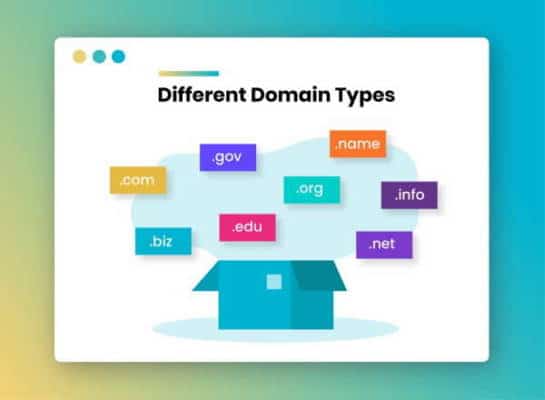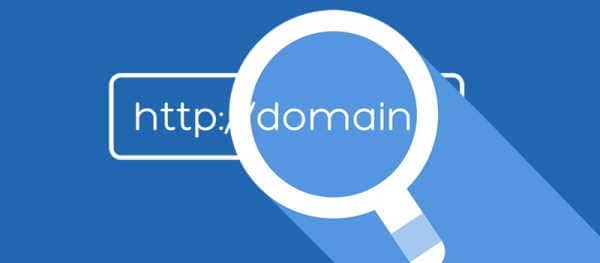What are domains? This kind of question must arise in the mind of you who are still very new in the world of web and hosting. In fact, this aspect is fundamental and must be understood by those of you who want to travel around the world. Of course, it will be a little dangerous if the new webmasters do not understand what a domain is and its function.
Therefore, we will invite all of you to learn about all kinds of domains. What it is Domain, domain examples? What are the types? Is there a specific way to select a domain? More details are below.
What is Domain and Hosting?
Domain is defined as a unique name or label used to identify servers on a network without using IP (internet protocol).
While the definition of web hosting is:
A physical place or machine that stores content (can be writing, media, etc.) for visitors. A website domain is like a piece of land in the internet world, while a website or web hosting is a building on it.
Domains are also often functioned as physical addresses that direct someone or visitors to the website. While web hosting acts as a place or physical building in which various files and databases are stored. The role of the domain in a website is very important.
What is Domain Structure?
Domain names have 2 important structures or elements- the website name and the domain name extension. For example, the domain name Youtube.com.
- Youtube is called the name of the website.
- .com is called a domain name extension.
Domain name extensions such as .com above are managed by an organization called ICANN.
In addition, ICANN (Internet Corporation for Assigned Names & Numbers) is also in charge of maintaining the database to avoid going anywhere and staying focused.
Domain Types

A website network certainly does not only consist of one or two aspects. Domains are also not only in the form of .com; there are many types of domains available.
Below are the types of domains that are popular and most widely used.
Types of Domains that are Widely Used
There are several types of domains that are popular, and perhaps most often we find, namely:
- Top Level Domains (TLD)
As the name implies, this type of domain is the top-level domain name on the internet network. The TLD is an extension at the end of the domain name. For example, www.techvaz.com, whose TLD is named after .com.
TLD domains are the names most widely used by the public, both for businesses and individuals. TLD is actually divided into 2, namely (gTLD/ Generic Top Level Domain? and (ccTLD/Country Code Level Domain).
Both are also common domain names used in the world.
- Generic Top Level Domains (gTLD)
What is Generic Top Level Domain?
Generic Domain is a special domain for agencies. This type of domain is directly below the dot behind the domain.

gTLD is a global domain and can be registered by anyone anywhere in the world. The following are the types of gTLD domain names:
- .net (network website)
- .com (commercial)
- .edu (education)
- .org (organization)
- .mil (military force)
- .info (information)
- .tv (television)
- .biz (business)
- .name (personal website)
- .pro (professional)
The functions of gTLDs vary; some are for business, education, organizations, etc., as the name implies.
- Country Code Top Level Domain s (ccTLD)
Is the domain assumed to be the country code? This domain name has a 2 letter extension behind it.
ccTLDs are country-specific domains that can only be registered and operated in certain countries.
Examples of this domain name, for example .ke (Kenya); .my (Malaysia); .cn (China); .us (United States), etc.
- Second Level Domains (SLD)
In contrast to TLD, SLD or 2LD is a domain name derived from SLD that is used more specifically. SLD itself refers to the name of the organization or agency and the country. Examples are ac.us, co.us, biz.us, etc.
This type of domain is usually used for universities, business communities, and corporates. You can also create an SLD domain by registering and buying it. FYI, SLD requires regular SLD maintenance and updates for at least one year.
For American SLD domains, examples are as follows:
- .go.us (a government agency).
- .co.us (commercial organization)
- .ac.us (academic or college)
- .sch.us (school/regulation/agency policy)
- .web.us (organizations, business entities, or individuals who carry out activities on www)
- .mil.us (military circles).
- ETC.
The example of the Secondary Level Domain name above is only for the United States.
Meanwhile, after the TLD, the name is adjusted to the respective country code (ccTLD) for other countries.
For example, .co.uk for the United Kingdom, .com.us for the United States, etc.
- Third Level Domains
Also called 3LD or subdomain, this domain name is usually given before the SLD and TLD.
What are domains and subdomains? These two aspects are not different. Subdomains are derived domains that are used by large websites or websites to facilitate access to certain content. Thus, the use of subdomains is very flexible because it can be adapted to the site owner’s needs.
Examples of subdomains, for example:
- webmail.yourdomain.com -> for email purposes.
- blog.yourdomain.com -> for blog purposes.
- lottery.yourdomain.com –> for lucky draw purposes,
- Etc
The types of domain names above are just a few examples that are very popular and are used more often. There are still lots of domain names that have various uses.
In fact, he said there are hundreds of millions of domain names currently registered in the world, from paid to free domains.
However, Slashdot said about 50,000 of the total domain names are no longer in use.
What are Domain Functions?
Previously, we have explained briefly about the types of domains and their respective functions. However, have you got an idea of what the real function of the domain is?
If not, well, let’s see what the domain functions are:
- Make it easy for website visitors to find the information they want.
- For branding, which is to create a business image that is more recognizable and professional for consumers.
- Make it easier for the system to identify when a user wants to access a website.
- Make it easy for users to remember a web address or site without using an IP address.
Knowing the various domain extensions and their functions can help you choose the right domain for your needs.
Tips for Choosing the Right Domain

Remember that domain names can also be used as branding? So, there must be a lot of consideration and research to create a domain name. Choosing a domain is not easy. Because apart from the stock, the budget is also very decisive.
Here are tips in choosing and determining the right domain name.
Use the Right Number of Domain Name Characters
- Domain names should be proportional, neither long nor short.
- You also have to consider the number of characters, not arbitrary.
- Usually, the number of characters ranges from 4-12 if you don’t have a specific brand for your website.
Use a Unique and Easy to Remember Name
Yes, a unique and easy-to-remember name is the main attraction for readers. A name that is easy to remember will also really help visitors to find the website. So, avoid complicated, long, and too general names. Oh yes, also consider the factors of values, norms, and SARA.
Relevant to Website Content
The compatibility between the domain name and the content on the website is certainly very important. Use the name as a characteristic that can determine the target market as well as the target area.
Use Popular Domain Name Extensions
Yups, which is more popular, is certainly more profitable, isn’t it? Some popular domains such as .net and .com are more recommended to use. Or you can also use a local domain, for example, .us.
Define Target Users
Before choosing a domain, you must first determine who and where your target consumer area is. If your market is targeted at the US audience, you can use a .us domain name, which of course is in American.
In addition to the tips above, it’s also a good idea to consider the use of certain words. For example, as much as possible, avoid using numbers and conjunctions that use a dash (-).
Conclusion
That was a brief explanation of what a domain is, its types, functions, and tips for choosing a domain. Domains have a big effect on the progress of your website later; you shouldn’t be so casual about this. For maximum benefits, you can use a trusted hosting service to help create a domain. You also have to be selective and adjust the domain selection to the existing budget.

